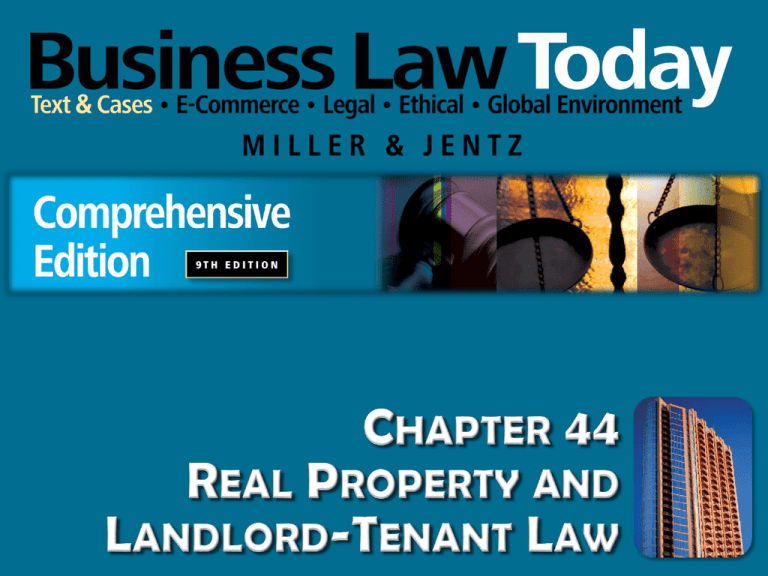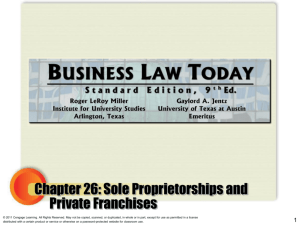
• What can a person who holds
property in fee simple absolute do
with the property?
• What are the requirements for
acquiring property by adverse
possession?
• What limitations may be imposed on
the rights of property owners?
© 2012 Cengage Learning. All Rights Reserved. May not be copied, scanned, or duplicated, in whole or in part, except for use as
permitted in a license distributed with a certain product or service or otherwise on a password-protected website for classroom use.
2
• What is a leasehold estate? What
types of leasehold estates, or
tenancies, can be created when real
property is leased?
• What are the respective duties of the
landlord and the tenant concerning
the use and maintenance of leased
property?
© 2012 Cengage Learning. All Rights Reserved. May not be copied, scanned, or duplicated, in whole or in part, except for use as
permitted in a license distributed with a certain product or service or otherwise on a password-protected website for classroom use.
3
• Real property is immovable and
includes:
–Land: land includes the soil, and all
natural and artificial structures on it
(unless agreed otherwise).
–Airspace and Subsurface Rights:
subsurface rights can be titled and sold
separately.
© 2012 Cengage Learning. All Rights Reserved. May not be copied, scanned, or duplicated, in whole or in part, except for use as
permitted in a license distributed with a certain product or service or otherwise on a password-protected website for classroom use.
4
• Real property is immovable and
includes (cont’d):
–Plant Life and Vegetation: crops can be
sold separately.
–Fixtures: personal property which is
permanently attached to land.
• CASE 44.1 APL Ltd. v. State of
Washington Department of Revenue
(2010). Why were the cranes fixtures?
© 2012 Cengage Learning. All Rights Reserved. May not be copied, scanned, or duplicated, in whole or in part, except for use as
permitted in a license distributed with a certain product or service or otherwise on a password-protected website for classroom use.
5
• Ownership in Fee Simple absolute
gives the owner the greatest
aggregation of rights, powers and
privileges possible under American law.
–Owner has indefinite right to exclusive
possession and use of property.
© 2012 Cengage Learning. All Rights Reserved. May not be copied, scanned, or duplicated, in whole or in part, except for use as
permitted in a license distributed with a certain product or service or otherwise on a password-protected website for classroom use.
6
• Life Estates.
–Estate that lasts for the life of some
specified individual.
–During life tenant’s ownership, she can
possess, use, and take the fruits of the
estate, but not take from the property
itself.
© 2012 Cengage Learning. All Rights Reserved. May not be copied, scanned, or duplicated, in whole or in part, except for use as
permitted in a license distributed with a certain product or service or otherwise on a password-protected website for classroom use.
7
• Nonpossessory Interests.
–Easement: right of a person to make
limited use of another person's real
property without taking anything from
the property.
–Profit: right to go onto another’s land
and take away some part of the land
itself or some product of the land.
© 2012 Cengage Learning. All Rights Reserved. May not be copied, scanned, or duplicated, in whole or in part, except for use as
permitted in a license distributed with a certain product or service or otherwise on a password-protected website for classroom use.
8
• Nonpossessory Interests (cont’d).
–Easement or Profit Appurtenant:
owner of property (dominant) has
right to go onto adjacent property
(servient). Easement goes with the
land at sale or transfer.
© 2012 Cengage Learning. All Rights Reserved. May not be copied, scanned, or duplicated, in whole or in part, except for use as
permitted in a license distributed with a certain product or service or otherwise on a password-protected website for classroom use.
9
• Nonpossessory Interests (cont’d).
–Easement or Profit in Gross: right to
go onto non-adjacent property by
business or utility company.
Easement goes with the land at sale or
transfer.
© 2012 Cengage Learning. All Rights Reserved. May not be copied, scanned, or duplicated, in whole or in part, except for use as
permitted in a license distributed with a certain product or service or otherwise on a password-protected website for classroom use.
10
• Nonpossessory Interests (cont’d).
–Creation of an Easement or Profit:
• Must be in writing created by deed,
contract, or will.
• Can be created by implication.
• Can be created by necessity.
• Can be created by prescription.
© 2012 Cengage Learning. All Rights Reserved. May not be copied, scanned, or duplicated, in whole or in part, except for use as
permitted in a license distributed with a certain product or service or otherwise on a password-protected website for classroom use.
11
• Nonpossessory Interests (cont’d).
–Termination of an Easement or Profit.
–License: revocable right of a person to
come onto other person’s land. Grants
no interest in the land.
• CASE 44.2 Roman Catholic Church of Our
Lady of Sorrows v. Prince Realty
Management, LLC (2008). How could the
defendant have protected itself better?
© 2012 Cengage Learning. All Rights Reserved. May not be copied, scanned, or duplicated, in whole or in part, except for use as
permitted in a license distributed with a certain product or service or otherwise on a password-protected website for classroom use.
12
• Deeds: written instrument setting forth
the interests in real property being
transferred. Necessary components:
– Names of Grantor and Grantee.
– Words evidencing intent to convey.
– Legally sufficient description of the land
(including metes and bounds).
– Grantor’s Signature.
– Delivery of the Deed.
© 2012 Cengage Learning. All Rights Reserved. May not be copied, scanned, or duplicated, in whole or in part, except for use as
permitted in a license distributed with a certain product or service or otherwise on a password-protected website for classroom use.
13
• Deeds:
–Warranty Deeds.
–Special Warranty Deed.
–Quitclaim Deed.
–Grant Deed.
–Sheriff’s Deed.
© 2012 Cengage Learning. All Rights Reserved. May not be copied, scanned, or duplicated, in whole or in part, except for use as
permitted in a license distributed with a certain product or service or otherwise on a password-protected website for classroom use.
14
• Deeds (cont’d).
–Recording Statutes.
• Recording a deed (or any interest in real
property) puts the public on notice of the
new owner’s interest in the land and
prevents the previous owner from
fraudulently conveying the same interest
to another buyer.
© 2012 Cengage Learning. All Rights Reserved. May not be copied, scanned, or duplicated, in whole or in part, except for use as
permitted in a license distributed with a certain product or service or otherwise on a password-protected website for classroom use.
15
• Will or Inheritance: property is
transferred upon death by will or state
statute.
• Adverse Possession: when person
possesses land of another for a certain
statutory period of time, she automatically
acquires title to the land, just as if there
had been a conveyance by deed.
© 2012 Cengage Learning. All Rights Reserved. May not be copied, scanned, or duplicated, in whole or in part, except for use as
permitted in a license distributed with a certain product or service or otherwise on a password-protected website for classroom use.
16
• Adverse Possession: (cont’d).
– Must be:
• Actual and exclusive.
• Open, visible and notorious.
• Continuous and peaceable.
• Hostile and adverse.
© 2012 Cengage Learning. All Rights Reserved. May not be copied, scanned, or duplicated, in whole or in part, except for use as
permitted in a license distributed with a certain product or service or otherwise on a password-protected website for classroom use.
17
• Eminent Domain. The Fifth
Amendment gives the government the
right to take (condemn) private land
for “public use” with just
compensation to owner.
–CASE 44.3 Drake v. Walton County
(2009). Was the government’s diversion
of water a “taking” ?
© 2012 Cengage Learning. All Rights Reserved. May not be copied, scanned, or duplicated, in whole or in part, except for use as
permitted in a license distributed with a certain product or service or otherwise on a password-protected website for classroom use.
18
• Created when owner or lessor
conveys right to possess or use the
property to a lessee (tenant) for
certain period of time.
• Fixed-Term Tenancy (or Tenancy for
Years): express contact for specified
period of time.
© 2012 Cengage Learning. All Rights Reserved. May not be copied, scanned, or duplicated, in whole or in part, except for use as
permitted in a license distributed with a certain product or service or otherwise on a password-protected website for classroom use.
19
• Periodic Tenancy: no definite
duration, but rent paid at certain
intervals.
• Tenancy at Will: termination of lease
without notice.
• Tenancy at Sufferance: tenant
wrongfully possesses property.
© 2012 Cengage Learning. All Rights Reserved. May not be copied, scanned, or duplicated, in whole or in part, except for use as
permitted in a license distributed with a certain product or service or otherwise on a password-protected website for classroom use.
20
• Lease Agreement can be oral or
written (oral may not be
enforceable).
• Lease gives Tenant the temporary
right to exclusively possess the
property.
© 2012 Cengage Learning. All Rights Reserved. May not be copied, scanned, or duplicated, in whole or in part, except for use as
permitted in a license distributed with a certain product or service or otherwise on a password-protected website for classroom use.
21
• Rights and Duties.
–Possession: tenant has “covenant of
quiet enjoyment.”
• Landlord has a duty to deliver actual (or
right to) physical possession.
• Eviction: landlord interferes with tenant’s
right to possession. Constructive eviction
: landlord fails to perform duties under the
lease, making use of premises impossible.
© 2012 Cengage Learning. All Rights Reserved. May not be copied, scanned, or duplicated, in whole or in part, except for use as
permitted in a license distributed with a certain product or service or otherwise on a password-protected website for classroom use.
22
• Rights and Duties (cont’d).
–Use and Maintenance of the Premises.
• Tenant is responsible for damages to
property, and cannot be a nuisance and
interfere with others quiet use of
property.
• Landlord is responsible to maintain
common areas such as stairs, pools, and
elevators.
© 2012 Cengage Learning. All Rights Reserved. May not be copied, scanned, or duplicated, in whole or in part, except for use as
permitted in a license distributed with a certain product or service or otherwise on a password-protected website for classroom use.
23
• Rights and Duties (cont’d).
–Implied Warranty of Habitability:
premises are safe and habitable for
humans to live in. Landlord is
responsible to keep leased premises in
good repair.
–Rent: rent can be withheld but it must
be put into escrow pending repairs.
© 2012 Cengage Learning. All Rights Reserved. May not be copied, scanned, or duplicated, in whole or in part, except for use as
permitted in a license distributed with a certain product or service or otherwise on a password-protected website for classroom use.
24
• Transferring Rights to Leased
Property.
–Assignment: lessee can transfer lease
to assignee, if allowable under lease.
Assignor is still liable for rent.
–Subleases: tenant transfers all or part
of premises for less than duration of
lease.
© 2012 Cengage Learning. All Rights Reserved. May not be copied, scanned, or duplicated, in whole or in part, except for use as
permitted in a license distributed with a certain product or service or otherwise on a password-protected website for classroom use.
25







